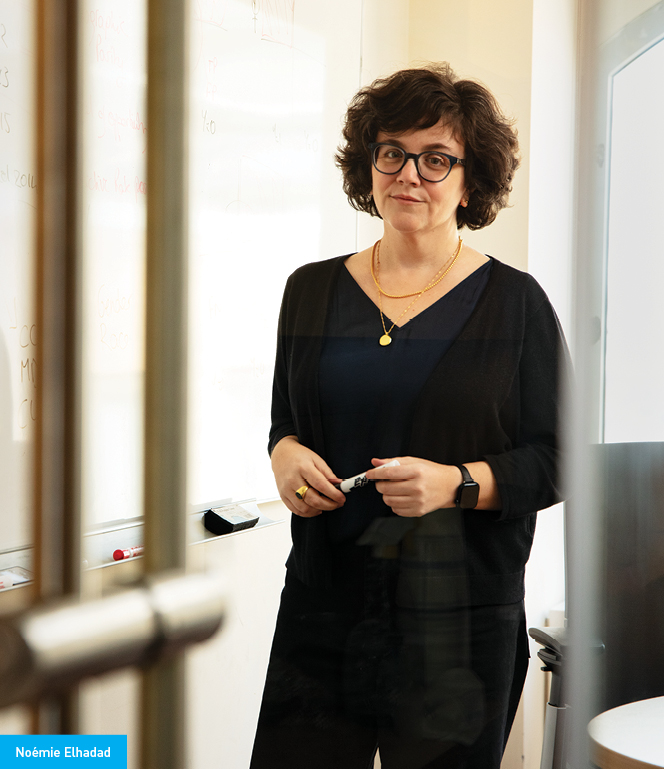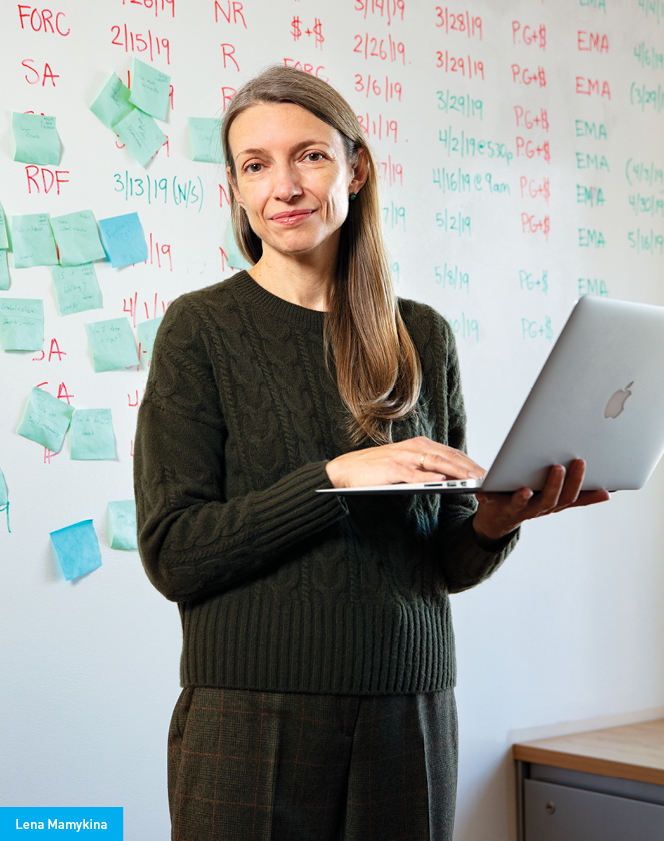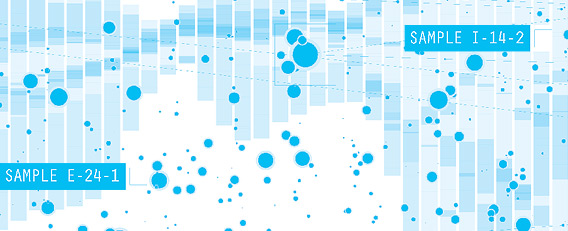A Digital Revolution for Patients
An algorithm crunches vast volumes of patient data to reveal that two common drugs, each considered safe, can cause a dangerous heart arrhythmia when taken together. Thousands of women use an app to record their experience with endometriosis, creating a rich database for scientists who study that disease. A chatbot suggests how a person with type 2 diabetes might alter the morning’s breakfast to lower his or her blood glucose level.
Those are just a few of the ways in which investigators in Columbia’s Department of Biomedical Informatics are applying data and advanced analytics to help transform many aspects of clinical care.
Using digital technologies such as machine learning and artificial intelligence, biomedical informatics extracts knowledge from complex biological data and health care records. “It has to do with collecting data, storing it in databases, managing those databases, and applying algorithms to support decisions of doctors or learn new things about biology or health care,” says George Hripcsak, MD, professor and chair of the department.

Biomedical informatics looks at life at every scale, “from atoms to continents,” adds Dr. Hripcsak. For example, one of the department’s researchers examines the activity of proteins. Dr. Hripcsak has done work at the tissue level. Other investigators focus on populations, comparing the efficacy of different drugs or helping public health organizations improve their services.
Columbia researchers make these discoveries in faculty labs and through initiatives such as Observational Health Data Sciences and Informatics, or OHDSI, pronounced “Odyssey,” an international collaboration for which Columbia’s Department of Biomedical Informatics serves as the coordinating center.
Global Reach
OHDSI applies advanced analytics at a large scale, mining electronic health records from about 810 million patients in 74 countries for new insights, with the goal of improving health care.
Researchers can tap this huge pool of observational data because OHDSI has developed a common data model for EHRs. The database at each institution has its own structure, but when a member researcher puts out a query—say, for data on side effects triggered by a certain medication—results arrive from every source around the world in the same format. “That lets us do studies on hundreds of millions of medical records, which normally would have been limited to a smaller sample and a smaller geography,” says Dr. Hripcsak.
“Similar to precision medicine, we can re-stratify and tailor recommendations that are focused on the characteristics of the individual."
High-powered software analyzes those millions of records with dazzling speed, revealing patterns and cause-and-effect associations that could not emerge in clinical trials or from smaller observational samples. For instance, when Dr. Hripcsak’s lab studied 57 hypertension drugs to measure their efficacy and possible side effects, advanced analytics let the researchers test a half-million hypotheses in about three months. “Usually, you’ll spend six months to a year carrying out one study—for one hypothesis, not half a million,” he says.
The lab of Noémie Elhadad, PhD, associate professor of biomedical informatics, uses patient records from OHDSI to study equity in health care. The aim is to learn how factors such as race, gender, and age affect the diagnoses patients receive and how soon they receive them.
 Photograph by Jörg Meyer.
Photograph by Jörg Meyer.Scientists have already done much work in this area—for example, finding that doctors take longer to diagnose some specific conditions in women than in men, says Dr. Elhadad. Advanced computing lets her lab take the research further. “We’re looking at 150 million patients and at every disease we can get our hands on.”
One finding to emerge so far is a large gender divide across a wide range of chronic conditions, where women obtain a diagnosis later than men on average, as well as large racial divide in types of mental health diagnoses assigned to patients. “Black patients are more likely to be diagnosed with stigmatizing conditions, such as substance use disorder,” Dr. Elhadad says. “White patients are more likely to be diagnosed with anxiety, depression, opioid addiction but less with illegal substance use.”
A Dangerous Pair
Large patient databases also help researchers uncover situations where otherwise-safe medications pose health risks. That’s the emphasis in the lab of Nicholas Tatonetti, PhD, associate professor of biomedical informatics.
One of Dr. Tatonetti’s major interests is drug interaction. Clinical tests required by the U.S. Food and Drug Administration should ensure that no drug that comes to market causes dangerous side effects. But tests on single drugs can’t address what might happen when a patient takes two drugs in combination.
 Photograph by Timothy Lee.
Photograph by Timothy Lee.Take ceftriaxone, an antibiotic often given to hospital patients, and lansoprazole, a widely used protein pump inhibitor used to treat gastrointestinal problems. Neither of those drugs is known to cause the heart arrhythmia called prolonged QT syndrome, which sometimes leads to more dangerous arrhythmias. But when Dr. Tatonetti’s lab analyzed thousands of patient records and many thousands of drug pairs, the algorithm raised a red flag on ceftriaxone and lansoprazole. Patients who took both at the same time seemed to run a higher risk of developing prolonged QT syndrome.
To substantiate that finding, the lab studied the drug pair further by collaborating with pharmacology researchers. First replicating standard tests on the individual drugs, researchers confirmed that neither drug impacts the hERG potassium channel, which helps to regulate heart rhythms. “But when you combine the drugs, we see a big effect on the channel, an effect that triggers prolonged QT syndrome. We’re seeing very strong evidence that this is a causal relationship,” says Dr. Tatonetti.
One major source of data for this work is NewYork-Presbyterian Hospital and its large collection of EHRs. Dr. Tatonetti also uses databases that track molecular activity, such as genetic databases available through biobanks.
“It’s critical to have not only a lot of data, but a diverse, rich data set,” Dr. Tatonetti says. “It enables us to apply machine learning and AI in a way that can correct for confounding biases and other factors and allow these signals, which have otherwise been overlooked or just not observed, to come through.”
By publishing papers and publicizing his lab’s findings, Dr. Tatonetti hopes to alert physicians to the risks posed by certain pairs of medication. “When the effects can be quite severe, as with the prolonged QT interval, there could be patients’ lives in the balance,” he says.
Insights From Patients
Along with the trove of data that EHRs and other sources provide, biomedical informatics research at Columbia also uses data that patients contribute themselves to research. That’s what’s happening in Phendo, a study in Dr. Elhadad’s lab that uses a mobile app to gather data from patients around the world who suffer from endometriosis. Since endometriosis isn’t well understood, and the medical community has no clear guidelines for treating it, Dr. Elhadad created a scientific resource based on patient experience. “The primary goal is to have a registry of patients and their day-to-day symptoms, the types of treatments they’re using—supplements, exercise, food that triggers symptoms—anything they can tell us about the disease and how their experience of disease changes from one day to the next,” she says.
Since 2017, about 15,000 women have contributed data to PHENDO, providing new insights into the nature of endometriosis. Contrary to traditional wisdom, this is not a disease of painful menstruation only, Dr. Elhadad says. In some patients, endometriosis causes gastrointestinal problems or generalized chronic pain. “The data are confirming the suspicions of a lot of researchers that the primary source is inflammatory in nature.”
Besides working to better understand the disease itself, Dr. Elhadad and her team are trying to learn how patients might better manage their own symptoms. This is a complex mission: Strategies that work well for one patient might be useless for another. So Phendo collects data on methods that individual patients try—such as exercise and changes to their diets—and patients report on what did or didn’t work.
In a simpler world, researchers could take strategies that worked for one patient and recommend them to others with similar characteristics—perhaps grouping women by age, ethnicity, or medical history, among other factors. That’s not possible with endometriosis. “We don’t know yet what it means to be a patient similar to another patient,” Dr. Elhadad says. “Physical exercise helps some patients tremendously with pain. For others, it exacerbates their symptoms.”
Dr. Elhadad’s lab is using an AI-based technology called reinforcement learning to develop self-management strategies one patient at a time. “It learns what happens to a patient as a result of different actions and determines which are the best actions to bring the patient closer to a goal such as reduction of pain or fatigue,” she says.
Digital Decision Aids
Rita Kukafka, DrPH, also uses bioinformatics to help tailor health care strategies to patients’ individual needs. Much of her recent work focuses on the risk women run of developing breast cancer.
 Photograph by Jörg Meyer.
Photograph by Jörg Meyer.Health care providers typically offer services and guidance about breast cancer at a population level, recommending, for example, that all women in a certain age range get annual mammograms. “But when we dig deeper, we realize that not all women are the same,” says Dr. Kukafka, professor of biomedical informatics at VP&S and professor of sociomedical sciences at
the Mailman School of Public Health. “Similar to precision medicine, we can re-stratify and tailor recommendations that are focused on the characteristics of the individual.”
Dr. Kukafka’s lab is developing internet-based tools to educate a woman and her health care provider about that woman’s particular risks and help her decide how to mitigate that risk—perhaps by getting more frequent mammograms, using other forms of screening, undergoing genetic testing, or taking “chemo prevention” pills. The researchers also provide “preference solicitation,” an exercise that helps a woman weigh various strategies in light of her own needs and desires.
“We use data and machine learning to give suggestions, but we’re also engaging people in being reflective, thinking about what went well and what didn’t.”
To determine the chances that a woman will develop breast cancer, the lab uses several well-established models that look at factors such as age, race, ethnicity, family history, history of breast biopsies, and breast density. The researchers then use decision support tools—interactive, digital teaching aids—to help a woman understand what her risk level means and how she might protect herself.
For instance, a recent study on genetic testing uses interactive games. “If a woman has a 20% risk, she would play something like a Pac-Man game and keep hitting this Pac-Man until she sees what
20% looks like,” says Dr. Kukafka. “The goal is to improve the accuracy of her risk perception.”
The decision aid then explains how genetic testing works and how it might help. Each woman chooses how to receive that information. She can pick an “information-dense” format—a PowerPoint presentation—or an “information light” format—a cartoon in English and Spanish about a woman who goes through the genetic testing experience.
In testing and refining digital decision aids, the lab doesn’t necessarily measure success by the number of women who opt for genetic testing or other strategies, says Dr. Kukafka. A woman might have sound reasons for not choosing a certain procedure at a particular time in her life. “The primary outcome is informed decision making, not uptake,” she says.
Chatbots For Healthier Menus
Type 2 diabetes is another area in which bioinformatics could help patients by serving up well-tailored health management strategies.
“People’s blood glucose levels have dramatically different responses to nutrition,” says Lena Mamykina, PhD, associate professor of biomedical informatics. Dr. Mamykina’s lab is testing a system that uses machine learning to discover how diabetes patients can reduce their blood glucose levels with customized adjustments to their meals and physical activity, using an AI-powered chatbot to coach them toward better health.
 Photograph by Jörg Meyer.
Photograph by Jörg Meyer.Launched in 2019 and funded by the National Institute of Diabetes and Digestive and Kidney Diseases, a clinical trial recruits diabetes patients through federally qualified community health centers in New York. The not-for-profit Clinical Directors Network collaborates on the project.
Participants in this trial log their meals and blood glucose levels and use FitBit to track physical activity. Machine learning software analyzes the data to determine how an individual’s meals and activity affect blood glucose. Then T2 Coach, an app developed in the Mamykina lab, uses a chatbot to engage with the patient via mobile phone text messages. Together, patient and chatbot set health goals and discuss ideas for reaching them.
The bot might say, “I noticed that you often have high blood glucose levels after dinners,” Dr. Mamykina says, and “I also notice that many of your dinners have more than three servings of carbohydrates.” It would then suggest ways to create meals with fewer carbs.
“These suggestions are specific to the individual,” says Dr. Mamykina. A different patient might get suggestions about adding protein to breakfast.
When the patient records the contents of a meal they are about to eat, the bot asks whether this meal will help the patient meet their health goals. “If they say yes, it will tell them, ‘Great job!’ If they say no, it will ask what got in the way and then ask what they can do differently tomorrow to avoid that barrier.”
The goal of this human-machine partnership is to keep patients in control of their experience, Dr. Mamykina says. “We use data and machine learning to give suggestions, but we’re also engaging people in being reflective, thinking about what went well and what didn’t.”
Beyond this project, the subject of human interaction with virtual coaches and assistants offers many opportunities for research, says Dr. Mamykina. Experience with products such as Apple’s Siri and Amazon’s Alexa helps people understand the benefits—and the limits—these technologies offer in the consumer realm. Designing AI-powered assistants to meet the demands of health care is even harder, she says. “When Alexa makes a mistake, somebody just gets annoyed. When our chatbots make a mistake, that may mislead people into making bad choices that could impact their health. The upside is compelling. With well-designed digital health tools, health coaching may become available to those most in need—individuals in medically underserved communities with limited access to health experts.”
- Log in to post comments


